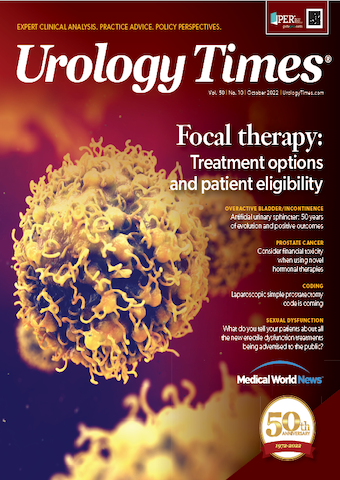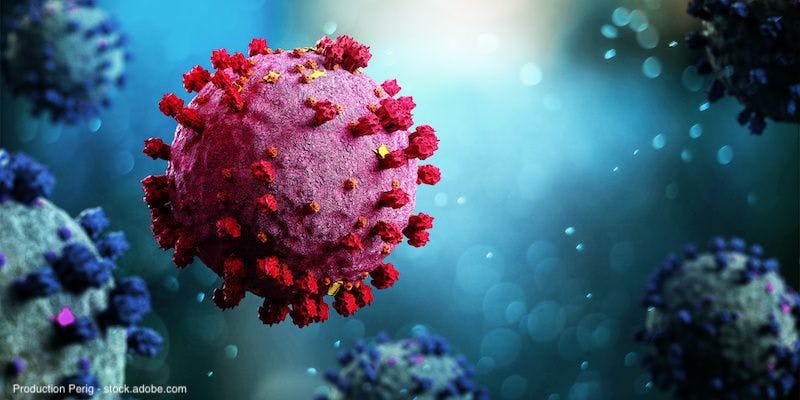Publication
Article
Urology Times Journal
Botox, sacral nerve stimulation highlighted as emerging OAB treatments for elderly patients
Author(s):
Two studies shared at the 2022 Annual Meeting of the South Central Section of the AUA highlighted onabotulinumtoxinA (Botox) and sacral nerve stimulation (SNS) as alternative treatment options for patients older than 70 years with overactive bladder (OAB).1,2
The AUA guidelines recommend behavioral therapies, such as bladder training, fluid management, and pelvic floor muscle training, as the first-line approach for patients with OAB. The guidelines also note that for some patients, combined behavioral therapies with pharmacologic management may be an appropriate first-line approach. Second-line treatments recommended by the AUA guidelines are oral anticholinergics and b-3 agonists.
Researchers at Houston Methodist Hospital and Texas A&M College of Medicine were interested in finding alternative treatment approaches, noting that oral anticholinergics have been linked to impaired cognition and b-3 agonists have been linked to negative effects on blood pressure. They also emphasized that elderly patients may be more likely to experience these side effects, making new options particularly significant for this population.
The goal of the 2 separate studies was to demonstrate that onabotulinumtoxinA and SNS are strong later-line options for elderly OAB patients with the potential to move up in the treatment paradigm.
onabotulinumtoxinA
The researchers on the onabotulinumtoxinA study conducted a retrospective chart review of patients who had received intradetrusor onabotulinumtoxinA (BTX-A) injections at their urology clinic between May 2015 and September 2021. Overall, the study included 103 patients aged >70 years, 83% of whom were female.
Before receiving their first injection, 91% of patients were voiding spontaneously. The most common symptoms were urinary urgency (98.1%), urinary incontinence (91%), and daytime frequency (83%). Prior pharmacologic management of OAB included anticholinergics in 66% of patients and b-3 agonists in 26.2% of patients. The doses of BTX-A injected were 100U (88.3%) and 200U (8.7%).
Overall, 4 patients required temporary de novo intermittent catheterization and 1 patient needed indwelling catheter placement. At follow-up, there were 19% patients (20%) with a symptomatic UTI.
OAB symptom assessment showed significant improvement in incontinence (87% of patients), urinary urgency (73%), daytime urinary frequency (65%), and nighttime frequency (57%). Over half (56.3%) of patients returned to the clinic for repeated injections because they were having good symptom response, and 88% did not need OAB medications after follow-up.
“BTX-A is well tolerated in patients older than 70 with significant improvement in all OAB symptom domains and significant reduction of their oral OAB medication needs. This provides an option for patients to limit oral medications with unwanted side effects for this special population potentially at an earlier time in the OAB management algorithm,” the authors wrote in their study conclusion.
Sacral nerve stimulation
The SNS study involved a retrospective chart review to identify patients aged ≥70 years who received SNS from 2018 to 2021 in the researchers’ Urology department. The review generated a study population of 36 patients who underwent percutaneous nerve evaluation (PNE) or staged SNS. Two-thirds (66.7%) of patients were female and 94% were voiding spontaneously. Patient symptoms included urinary urgency (94%), urge incontinence (92%), nocturia (86%), and frequency (81%). Prior treatment included b-3 agonists (83%), anticholinergics (69%), and combination therapy (19%).
Overall 22 (61%) of the 36 patients chose PNE placement, and the remaining 14 patients (39%) opted for staged nerve stimulation placement without a prior PNE. Eighteen (82%) of the 22 patients who received PNE testing had improved symptoms and chose to receive full SNS implantation. Improvement in urinary symptoms was reported in nearly three-fourths (71%) of the 14 patients who initially received the staged procedure. Further, of the patients who underwent SNS placement, improvement was reported in daytime frequency (88% of patients), nocturia (74%), urgency (83%), and urge urinary incontinence (83%).
The researchers noted that, “There was no significant difference in outcomes between patients who had a positive PNE response versus full SNS placement.”
In their concluding remarks, the study authors wrote, “SNS therapy is a safe and effective option for treatment of elderly patients with overactive bladder who may have failed medications or behavioral modifications. Based on this pilot retrospective chart review, first- and second-line therapies are not predictive of how patients will respond to nerve stimulation placement. Furthermore, PNE to full implant and staged SNS placement have equivalent symptom benefit in the elderly.”
References
1. Hernandez N, Miceli L, Stading R, et al. Outcomes of intradetrusor injection of onabotulinumtoxinA (BTX-A) in the elderly population. Presented at: 101st Annual Meeting of the South Central Section of the AUA. September 7-10, 2022; Coronado, CA. Poster 69.
2. Stading R, Hernandez N, Saleh A, et al. Outcomes and safety of sacral nerve stimulation placement in the elderly population with overactive bladder. Presented at: 101st Annual Meeting of the South Central Section of the AUA. September 7-10, 2022; Coronado, CA. Poster 70.































